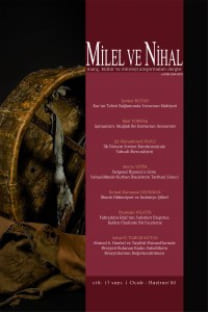Köken Tartışmaları Ekseninde Katarlara Dair Tarih Yazımındaki Güncel Paradigma Değişikliği
Katarlar, Bogomiller, Pavlikenler, Düalizm, Katarlar tarih yazımı, Hıristiyan Heresisi
Current Paradigm Shift in the Cathars' Historiography on the Axis of Debate of the Origin
Cathars, Bogomils, Paulicians, Cathar Historiography, Dualism, Christian Heresy,
___
- Arberth, John. Contesting the Middle Ages: Debates That Are Changing Our Narrative of Medieval History, Taylor & Francis Group, 2018.
- Arnold, John, Biller, Peter. Heresy and inquisition in France, 1200-1300, Manchester University Press, 2016.
- Arnold, John H. Inquisition and Power. University of Pennsylvania Press, Inc, 2013.
- Barbezat, Michael D. Burning Bodies: Communities, Eschatology, and the Punishment of Heresy in the Middle Ages, 2018.
- Biget, Jean-Louis, Hérésie et inquisition dans le Midi de la France, Paris: Picard, (2007).
- Biller, Peter, “Goodbye to Cathars”, Cathars in Question.
- Borst, Arno. Die Katharer, Monumenta Germaniae Historica Schriften 12, Stuttgart, 1953.
- Brunn Uwe. Des contestataires aux “Cathares” Discours de réforme et propagande antihérétique dans les pays du Rhin et de la Meuse avant l’Inquisition (Paris: Institut d’Études Augustiniennes, 2006).
- Bruschi, Caterina, and Peter Biller. 2003. Texts and the repression of medieval heresy. Woodbridge, Suffolk, UK: York Medieval Press.
- Walker Reid Cosgrove, “Clergy and Crusade: the church in Southern France and the Albigensian Crusade” Saint Louis University, 2011.
- Dondaine, “L’hiérarchie Cathare en Italie”, AFP, XIX, 1949, XX, 1950.
- Douais, L’Abbe C. Les Albigeois Leurs Origenes Action de L’eglise Au XIIe Siécle, 1. Baskı, Paris: Librarie Academique, 1879.
- Frasetto, Michael. Heretic lives: Medieval heresy from Bogomil and the Cathars to Wyclif and Hus. London: Profile Books. 2007.
- _______________, (ed.)Heresy and the Persecuting Society in the Middle Ages: Essays on the Work of R.I. Moore. Leiden: Brill, 2006.
- Hamilton, Janet&Bernard, ve Yuri Stayenov, Bizans Döneminde (650-1405) Hıristiyan Düalist Heretikler,(Çev. Leyla Kuzucular) Yurt Kitap Yayın, 2011.
- Lambert, Malcolm. Medieval Heresy: Popular Movements from the Gregorian Reform to the Reformation, Oxford: Blackwell, 2002.
- _______________, The Cathars, Blackwell Publishing, 2007.
- Léglu, Catherine, Rebecca Rist, and Claire Taylor. The Cathars and the Albigensian Crusade: A Sourcebook, 2014.
- Moore, I. R. The Formation of a Persecuting Society : Authority and Deviance in Western Europe, 950-1250, Blackwell Publishing, 2009.
- __________, The war on heresy: faith and power in medieval Europe.,London : Profile Books, 2014.
- __________, The Origins of European Dissent, Oxford, 1985.
- __________, The Birth of Popular Heresy, Documents of Medieval History, 1, London, 1975.
- Obolensky, Dimitri The Bogomils: A Study in Balkan Neo-Manicheism, 2. Baskı ,Twickenham: Cambridge University Press, 1972.
- Pegg, Mark. The Corruption of Angels: the Great Inquisition of 1245-1246, Princeton University Press 2009.
- __________, “The Paradigm of Catharism; or, the Historians’ Illusion,” Sennis, Cathars in Question, s. 21.
- __________, “Principles at Stake,” Principles at Stake: The Debate of April 2013 in Retrospect”, Cathars in Question, 2016.
- Puech, H., A. Vaillant, “Le Traité Contre les Bogomiles de Cosmas le Prétre : Traduction et étude”, Travaux publiés par l'Institut d'Études Slaves, XXI. Paris, 1945.
- Roach, Andrew, James Simpson, Heresy and the Making of European Culture Medieval and Modern Perspectives, Routledge, 2013. Roach, Andrew. 2002. Heresy and medieval society, 1100-1320. Harlow: Longman.
- RUNCİMAN, Steven The Medieval Manichee: a Study for the Christian Dualist Heresy. Cambridge: Cambridge University Press. 1982. Russell, Jeffrey “Interpretations of the Origins of Medieval Heresy”, Medieval Studies, 25, no 2, (1963)
- Sackville, Lucy J. Heresy and Heretics of the Thirteenth Century: The Textual Representations, York: York Medieval Press, 2011.
- Sennis, Antonio C. (ed.) Cathars in Question, York Medieval Press, 2016.
- Söderberg, Hans. 1949. La Religion des Cathares. Almqvist & Wiksell.
- Taylor, Claire Heresy, Crusade and Inquisition in Medieval Quercy, York University Press, 2011.
- ___________, Heresy, Crusade and Inquisition in Medieval Quercy. Cambridge: Cambridge University Press, 2013.
- Théry-Astruc, Julien, “The Heretical Dissidence of the ‘Good Men’ in the Albigeois (1276–1329): Localism and Resistance to Roman Clericalism,” Cathars in Question, 2016.
- Townsend, Anne Bradford, Cathars of Languedoc as Heretics: From the Perspectives of Five Contemporary Scholars, Basılmamış Doktora Tezi, Union Institute&University Cincinnati, Ohio, 2007.
- Zerner, Monique (ed.), Inventer l’hérésie? Discours polémiques et pouvoirs avant l’inquisition, Nice: Centre d’Études Médiévales, 1998.
- İnternet sitesi Cathars in Question: A Responce to Pete Biller, Son güncelleme, 9 Aralık 2020, http://rimoore.net/2016/11/13/cathars-in-question-a-response-to-pete-biller/ https://www.york.ac.uk/res/doat/project/
- ISSN: 1304-5482
- Yayın Aralığı: Yılda 2 Sayı
- Başlangıç: 2003
- Yayıncı: Milel ve Nihal: Eğitim, Kültür ve Düşünce Platformu Derneği
Hıristiyan Doktrinlerin Delillendirilmesinde Kur’an'ın Kullanılması
Köken Tartışmaları Ekseninde Katarlara Dair Tarih Yazımındaki Güncel Paradigma Değişikliği
Hıristiyan Doktrinlerin Delillendirilmesinde Kur’an-ı Kerim’in Kullanılması
Nûreddîn es-Sâbûnî’ye Göre Kudret-Fiil İlişkisi Çerçevesinde İnsan Fiilleri ve Sorumlu Özgür Kişilik
Erken Dönem Kur’an Tefsirlerine Göre Medine Yahudilerinin Kimlik ve Geleneklerine Genel Bir Bakış
Mukadder Sipahioğlu, Antik Mısır’da Rahip Sınıfı
Hıristiyan Doktrinlerin Delillendirilmesinde Kur’an'ın Kullanılması
Zafer Duygu, İnciller Güvenilir Metinler midir? -Metodolojik ve Karşılaştırmalı Analizler-
Emine Battal, Kıyametin Gölgesinde: Yeni Dini Hareketler ve Şiddet
